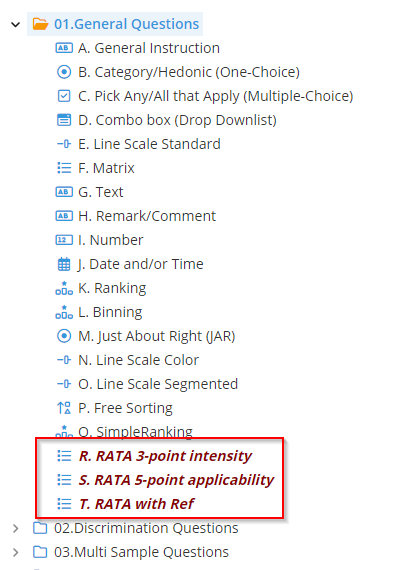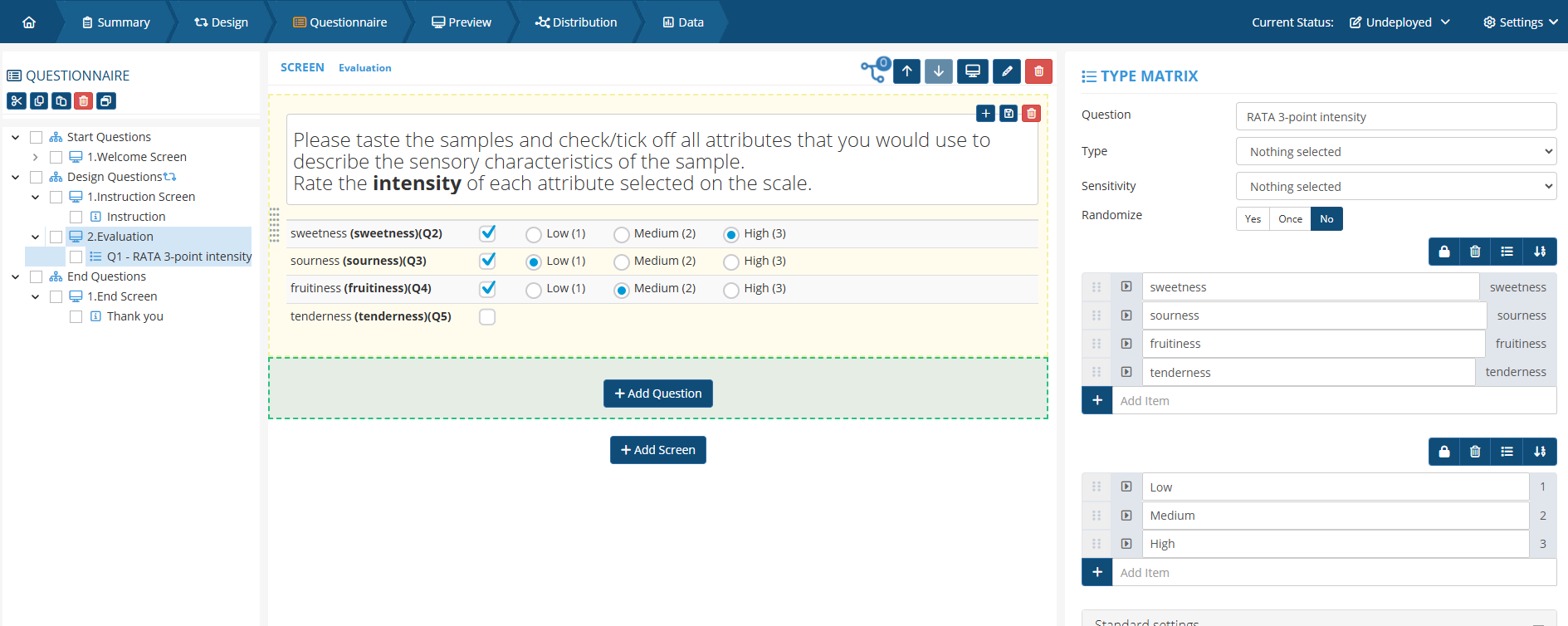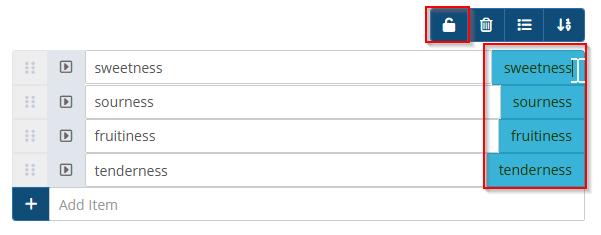Rate All That Apply (RATA)
Introduction
Rate-All-That-Apply (RATA) is an advanced sensory evaluation technique designed to efficiently capture sensory characteristics of products. As the name suggests, RATA asks panellists to select all relevant sensory attributes that apply to a sample and then rate the intensity of those selected attributes on a predefined scale. This method blends the rapid assessment nature of CATA (Check-All-That-Apply) with the intensity evaluation used in traditional descriptive analysis, making it a versatile option for both exploratory and confirmatory sensory research.
Set Up RATA Questionnaire
Step 1.
In order to efficiently build a questionnaire to use for RATA method, you must create a project from scratch with design or use the RATA Template. In the design section of your questionnaire you can add one or more of the RATA question types.

Step 2.
You can now adjust the text you want to display, add your attributes and the levels of intensity you want to show the panelists.

By default, the question type will be a Matrix that is by default set up as Rata.

Step 3.
Make sure that after you add the attributes, you modify their values to reflect the actual name of the attributes. You can do this my clicking on the lock icon above the attributes list. This will allow you to modify the values' text.

In order to efficiently build a questionnaire to use for RATA method, you must create a project from scratch with design or use the RATA Template. In the design section of your questionnaire you can add one or more of the RATA question types.
Step 2.
You can now adjust the text you want to display, add your attributes and the levels of intensity you want to show the panelists.
By default, the question type will be a Matrix that is by default set up as Rata.
Step 3.
Make sure that after you add the attributes, you modify their values to reflect the actual name of the attributes. You can do this my clicking on the lock icon above the attributes list. This will allow you to modify the values' text.
Step 4.
Adjust the settings of the RATA question as you desire.
Adjust the settings of the RATA question as you desire.
- In the Standard settings you will be able to add additional information for your panelists. The information will be displayed under a info "i" icon and will appear as panelists are hovering the mouse over it
You can also add extra information per attribute by opening the settings of each attribute. - In the Advanced settings you have various settings allowing you to display product related information, image, values, etc. More information about each setting available in this section can be found as you are hovering the mouse on top of them.
- In the Layout settings you have the possibility to customize the way panelists see the questions. You can in here adjust sizing, color and font.
- The Multi sample settings allow you to display the RATA question type for multiple samples at once on the same screen.
- In the Branching setting you can show or hide the question in cause in relation to other question types of the questionnaire. More information about this functionality as well as how to set it up can be found in the following Knowledge Base article:
https://support.eyequestion.nl/portal/en/kb/articles/show-and-hide-specific-part-s-of-a-questionnaire - Last but not least, the Analysis settings offer the possibility to link your RATA question to a different question.
Analysis
- Frequency Tables Categorical Data - https://support.eyequestion.nl/portal/en/kb/articles/frequency-tables-categorical-data
- Principal Component Analysis (PCA) - https://support.eyequestion.nl/portal/en/kb/articles/principal-component-analysis-pca
For more information about how to run any of the analysis mentioned above, please check the Knowledge Base articles provided.
Related Articles
Check All That Apply (CATA)
Introduction The "Check-All-That-Apply" (CATA) method is utilized in sensory evaluation to collect information regarding the sensory characteristics of a product. In this method, participants are presented with a predetermined list of sensory ...Temporal Check All That Apply (TCATA)
Introduction The Temporal Check All That Apply (TCATA) method builds upon the traditional CATA (Check All That Apply) question by introducing a dynamic element. It enables continuous selection and deselection of attributes based on their relevance to ...How Do I Use the Answer of a Previous Question as Options for a New Question
Introduction When building your questionnaire there are instances where panellists may need to reference their previous selections or inputs within a questionnaire. For example, imagine a scenario where respondents are asked to select all the brands ...Two Step Double-Faced Applicability Test
Introduction In the 'double-faced applicability' test, each attribute is presented with a “double-faced” approach, featuring two descriptors (a pair of semantic-differential descriptors) separately presented in the questionnaires to represent both ...Data Cleaning
Introduction Following data collection, it's essential to ensure the validity of the collected data and address any instances where participants may have completed the questionnaire without due attention. To tackle this issue, we've introduced a ...